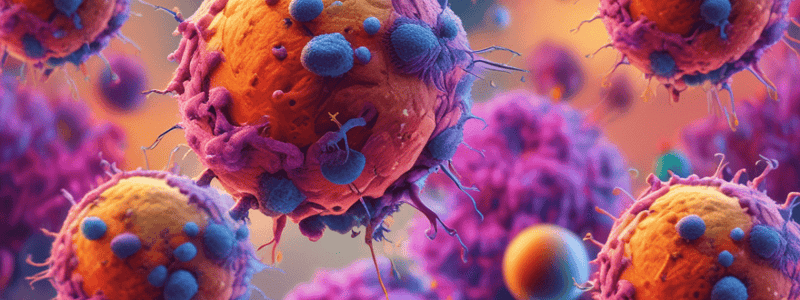Podcast
Questions and Answers
What is the primary role of cytotoxic T cells (CD8+ T cells)?
What is the primary role of cytotoxic T cells (CD8+ T cells)?
- To promote local innate defense against pathogens.
- To directly attack and kill other cells that display the antigen they have been sensitized to. (correct)
- To coordinate the adaptive immune response by secreting cytokines.
- To undergo isotype switching and differentiate into plasma cells.
Which of the following best describes the function of B cell memory?
Which of the following best describes the function of B cell memory?
- B cell memory is necessary for isotype switching to occur.
- B cell memory allows for a rapid and robust antibody response upon re-exposure to the same antigen. (correct)
- B cell memory is responsible for the non-specific release of antibodies.
- B cell memory enables the production of large amounts of antibodies as plasma cells.
What is the primary role of T helper (TH) cells in the adaptive immune response?
What is the primary role of T helper (TH) cells in the adaptive immune response?
- TH cells coordinate the adaptive immune response by secreting cytokines. (correct)
- TH cells undergo isotype switching and differentiate into plasma cells.
- TH cells directly attack and kill cells displaying the antigen they recognize.
- TH cells promote local innate defense against pathogens.
What is the difference between active and passive immunity?
What is the difference between active and passive immunity?
Which of the following best describes the relationship between T helper (TH) cells and B cells?
Which of the following best describes the relationship between T helper (TH) cells and B cells?
How do cytokines characteristic of TH1 and TH2 cells differ in their effects on the immune response?
How do cytokines characteristic of TH1 and TH2 cells differ in their effects on the immune response?
Which type of hypersensitivity reaction involves the production of IgG antibodies that bind to modified cells and make them susceptible to destruction?
Which type of hypersensitivity reaction involves the production of IgG antibodies that bind to modified cells and make them susceptible to destruction?
Which type of hypersensitivity reaction is mediated by the deposition of immune complexes and the activation of inflammatory cells and the complement cascade?
Which type of hypersensitivity reaction is mediated by the deposition of immune complexes and the activation of inflammatory cells and the complement cascade?
Which type of T helper cells produce cytokines that recruit and activate eosinophils, leading to their degranulation and tissue injury?
Which type of T helper cells produce cytokines that recruit and activate eosinophils, leading to their degranulation and tissue injury?
Which of the following is NOT a function of TH1 cells?
Which of the following is NOT a function of TH1 cells?
Which type of T cells recognize soluble antigens and release IFN-γ to activate macrophages, causing tissue injury?
Which type of T cells recognize soluble antigens and release IFN-γ to activate macrophages, causing tissue injury?
Which cytokines are produced by TH2 cells?
Which cytokines are produced by TH2 cells?
What is the role of Tfh cells in the immune response?
What is the role of Tfh cells in the immune response?
Which type of immune cells are responsible for direct cytotoxicity in Type IV hypersensitivity reactions?
Which type of immune cells are responsible for direct cytotoxicity in Type IV hypersensitivity reactions?
Which type of T cell is associated with CD8+ coreceptor molecules?
Which type of T cell is associated with CD8+ coreceptor molecules?
What is the primary role of B cells in the immune system?
What is the primary role of B cells in the immune system?
Which type of shock is associated with third spacing of fluids?
Which type of shock is associated with third spacing of fluids?
Curling ulcers are most commonly associated with which condition?
Curling ulcers are most commonly associated with which condition?
What type of risk is associated with cancer, according to the text?
What type of risk is associated with cancer, according to the text?
What is the term for SCC that arises from non-healing wounds, such as burns?
What is the term for SCC that arises from non-healing wounds, such as burns?
In electrical burns, what is a common offending agent-related complication?
In electrical burns, what is a common offending agent-related complication?
Which of the following is a potential risk associated with frictional injuries?
Which of the following is a potential risk associated with frictional injuries?
Which classification of burn involves healing that can take several months with long-term scarring?
Which classification of burn involves healing that can take several months with long-term scarring?
Inadequate end organ perfusion can lead to which of the following conditions?
Inadequate end organ perfusion can lead to which of the following conditions?
What is the primary concern when discussing the 'shocked state' according to the text?
What is the primary concern when discussing the 'shocked state' according to the text?
"Post-burn hypermetabolism" is a complication typically seen in which type of burn?
"Post-burn hypermetabolism" is a complication typically seen in which type of burn?
Which of the following is NOT a type of risk mentioned in the text?
Which of the following is NOT a type of risk mentioned in the text?
Which condition is primarily associated with inhalation injury, as discussed in the text?
Which condition is primarily associated with inhalation injury, as discussed in the text?
Which of the following is a consequence of thermal burns with a high total body surface area (TBSA) involvement?
Which of the following is a consequence of thermal burns with a high total body surface area (TBSA) involvement?
What is the primary cause of hypovolaemic shock in patients with extensive burns?
What is the primary cause of hypovolaemic shock in patients with extensive burns?
Which of the following is a risk factor for compartment syndrome in patients with circumferential burns?
Which of the following is a risk factor for compartment syndrome in patients with circumferential burns?
Which type of shock is associated with radiation burns?
Which type of shock is associated with radiation burns?
Which of the following is a consequence of the postburn hypermetabolic state?
Which of the following is a consequence of the postburn hypermetabolic state?
Which zone of burn injury is characterized by coagulative necrosis and is considered irreversible?
Which zone of burn injury is characterized by coagulative necrosis and is considered irreversible?
Which type of shock is characterized by a decrease in systemic vascular resistance?
Which type of shock is characterized by a decrease in systemic vascular resistance?
What is the main cause of cardiogenic shock?
What is the main cause of cardiogenic shock?
Which of the following is a common symptom of hypovolemic shock?
Which of the following is a common symptom of hypovolemic shock?
Which type of shock is characterized by a critical reduction in blood flow, leading to cellular dysfunction?
Which type of shock is characterized by a critical reduction in blood flow, leading to cellular dysfunction?
Which type of shock is associated with third spacing of fluids?
Which type of shock is associated with third spacing of fluids?
What is the primary treatment for hypovolemic shock?
What is the primary treatment for hypovolemic shock?
What is the primary characteristic of septic shock?
What is the primary characteristic of septic shock?
Which type of shock is commonly associated with widespread inflammation and organ damage?
Which type of shock is commonly associated with widespread inflammation and organ damage?
What is the main focus of treatment for hypovolemic shock?
What is the main focus of treatment for hypovolemic shock?
Which type of shock involves addressing the underlying cause and often using vasopressors for treatment?
Which type of shock involves addressing the underlying cause and often using vasopressors for treatment?
What distinguishes distributive shock from other types of shock?
What distinguishes distributive shock from other types of shock?
What is a potential complication of mismanaged fluid resuscitation?
What is a potential complication of mismanaged fluid resuscitation?
Which type of shock is characterized by obstructed blood flow leading to decreased cardiac output?
Which type of shock is characterized by obstructed blood flow leading to decreased cardiac output?
What type of solution is commonly used for fluid resuscitation to improve organ perfusion?
What type of solution is commonly used for fluid resuscitation to improve organ perfusion?
In which type of shock does inadequate cardiac function lead to systemic hypoperfusion?
In which type of shock does inadequate cardiac function lead to systemic hypoperfusion?
Which of the following is a potential complication of fluid resuscitation in the context of hemorrhagic shock?
Which of the following is a potential complication of fluid resuscitation in the context of hemorrhagic shock?
What is the primary aim of fluid resuscitation in the context of cardiogenic shock?
What is the primary aim of fluid resuscitation in the context of cardiogenic shock?
What is the primary cause of obstructive shock?
What is the primary cause of obstructive shock?
Which of the following conditions can lead to cardiogenic shock?
Which of the following conditions can lead to cardiogenic shock?
What is a common symptom of obstructive shock that may be observed?
What is a common symptom of obstructive shock that may be observed?
Which of the following is NOT a potential treatment approach for obstructive shock?
Which of the following is NOT a potential treatment approach for obstructive shock?
What is a common symptom of cardiogenic shock that may be observed?
What is a common symptom of cardiogenic shock that may be observed?
Which type of shock is most likely to require fluid resuscitation as part of the treatment approach?
Which type of shock is most likely to require fluid resuscitation as part of the treatment approach?
Flashcards are hidden until you start studying



